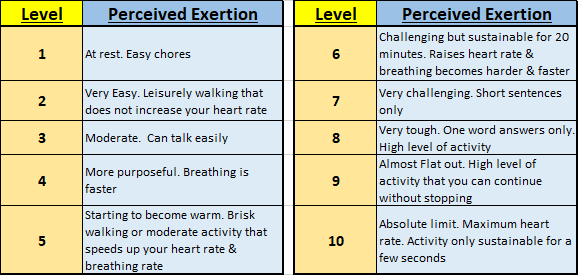Things You Need to Know About Rate of Perceived Exertion In Fitness
What does RPE stand for in fitness? What is the importance of RPE when it comes to working out? In this blog post, we will answer these questions and more! We will discuss what RPE is, how to use it, and its benefits. If you’re looking to get the most out of your workouts, read on!
What is Rate of Perceived Exertion (RPE)?

RPE measures how hard you feel like you are working during exercise. It is essential because it can help you gauge how much effort to put forth to reach your fitness goals.
There are different ways to measure RPE, but the Borg Scale is one of the most common. This scale goes from 0-20, with 0 being no exertion and 20 being maximal effort.
It is important to note that RPE is subjective, which means that different people may have different perceptions of how hard they are working at any given time. It is important to listen to your body and not push yourself too hard.
If you are new to exercise, it is important to start slow and gradually increase your intensity as you get more comfortable with working out. A good rule of thumb is to keep your RPE at a level that feels like a “somewhat hard” effort. This would be equivalent to a Borg Scale rating of around 13-15.
As you become more fit, you will be able to handle higher intensity levels and may even find that you enjoy working out at a higher RPE. However, it is still important to listen to your body and not push yourself too hard.
If you are unsure of what level of intensity is right for you, it is always a good idea to consult with a certified personal trainer or other fitness professional.
What are the benefits of using RPE in fitness programming and training?
There are a few key benefits to RPE in fitness programming and training. First, it can help to gauge the intensity level that someone is working at during their workout. Second, it can be used to progressively overload the body and ensure that athletes are constantly challenging themselves and making gains. Finally, RPE can help create more specific and individualized training programs.

RPE can be a helpful tool for both coaches and athletes alike. It can help ensure that athletes are working at the right level of intensity and challenging themselves sufficiently. If you’re looking to improve your fitness levels, consider using RPE in your training!
How can you effectively use RPE to monitor your intensity during a workout or training session?
One way to do this is by using a scale of 0-20, with 20 being 100% effort and 0 being no effort at all. For example, if you’re working out and feel like you’re at an intensity of about eight or nine, that would be moderate.
If you’re new to RPE, it’s essential to start slowly and gradually increase intensity as you become more comfortable with the system.
It’s also important to keep in mind that how you feel on any given day can affect your perceived level of effort.
For example, if you’re feeling well-rested and energized, you may be able to push yourself harder than you would on a day when you’re feeling fatigued.
Remember, the goal is to find what works best for you and be consistent with your intensity levels from workout to workout.

Are there any guidelines or tips for beginners when using RPE to gauge their intensity levels during a workout or training session?
Some guidelines can be followed when first incorporating RPE into your fitness routine. Here are a few tips to get you started:
- Start by using a scale of 0-100. Zero is no effort at all, and 100 is an all-out maximal effort.
- Use this scale to rate how hard you feel working during a specific exercise, movement, or drill.
- Be as honest as possible when assigning a number to your level of effort.
Remember that RPE is meant to be a guide and not a strict rule. There will be days when you may feel like you can push yourself harder than your RPE says, and that’s okay! Just listen to your body and go at a pace that feels comfortable for you.
What are some common misconceptions about Rate of Perceived Exertion?
One common misconception about RPE is that it should always be kept low, especially when working out for long periods. However, fitness experts generally agree that there’s no need to keep your RPE too low. Keeping it at a moderate level can help you improve your endurance and overall performance.
Another misconception is that RPE is only relevant to cardiovascular exercise. However, this isn’t the case either – RPE can be just as useful for strength training and other types of exercise.
Finally, some people believe that they need to wait until they’re feeling exhausted before they start using RPE as a guide. However, this isn’t necessary either. Starting to use RPE early on in your workout can help you pace yourself better and avoid over-exerting yourself.
Keep these misconceptions in mind the next time you use RPE to guide your workouts. And remember, if you have any questions about how to use RPE, don’t hesitate to ask a certified fitness professional for help.
How can you use RPE to adjust your workouts and training programs as you progress over time?
As you become more fit, you can use RPE to make your workouts harder. For example, if you’re used to working out at an RPE of “easy,” you can gradually increase the intensity until you’re working out at an RPE of “hard.” This will help you continue to see results as your fitness level improves.
You can also use RPE to tailor your workouts to your current fitness level. For example, if you’re feeling exhausted, you may want to back off the intensity a bit and work out at a lower RPE. On the other hand, if you’re feeling fresh and energized, you can push yourself harder by working out at a higher RPE.
Using RPE, you can ensure that your workouts are always challenging yet manageable. This is an essential part of helping you maintain your motivation and preventing burnout.
So, next time you’re planning a workout, think about how it feels on a scale of “easy” to “hard.” This will help you find the perfect intensity level to challenge yourself and see results.
The next time you are in the gym, keep these things in mind when trying to figure out your rate of perceived exertion. Use this information to work harder, smarter, and achieve your fitness goals.



